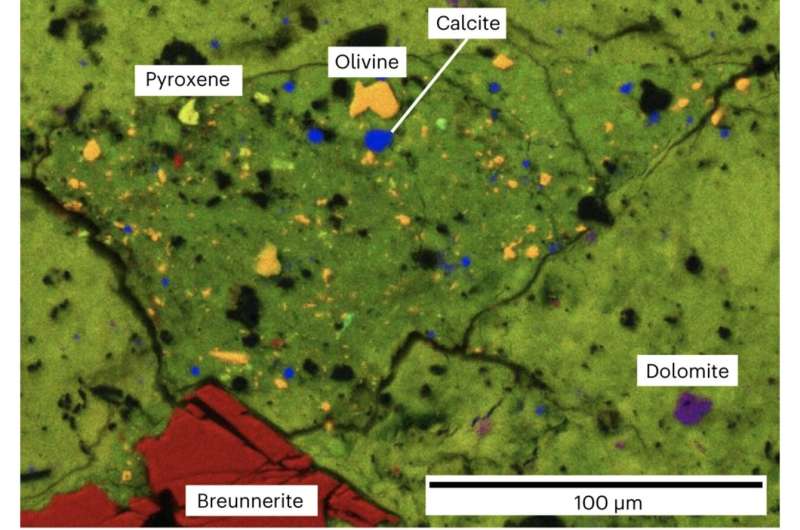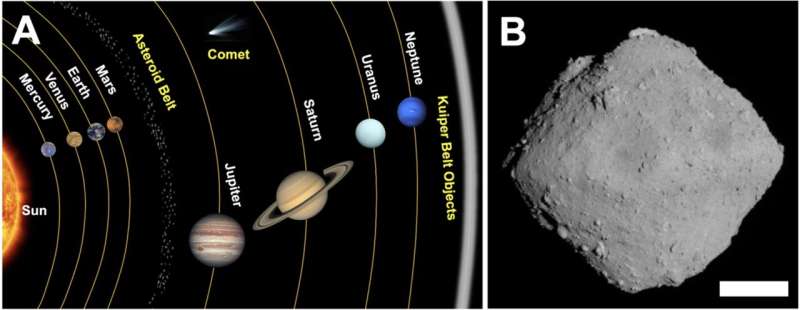Japan’s Aerospace Exploration Agency sent the Hayabusa2 spacecraft to 162173 Ryugu in 2019, an asteroid in orbit near Earth that is comprised of rocky fragments originating from a larger parent body. Multiple rovers brought samples from the asteroid’s surface back down to Earth for scientists to study.
The samples are indicative of chemically primitive meteorites, similar to Ivuna-type chondrites, and contain particular chemical compounds that suggest the presence of water. In particular, alterations of the asteroid’s surface by water on the parent body, at estimated temperatures up to 150°C, produced secondary minerals (including phyllosilicates, carbonates, sulfides and oxides) and the researchers aimed to understand the timescale and conditions over which these changes occurred.
Charting the asteroid’s formation, collaborative studies by 89 scientists from global universities and research institutes, published in Nature Geoscience, focuses on two particular compounds: calcium carbonate (calcite) and calcium–magnesium carbonate (dolomite). The carbon source for these carbonates is postulated to be carbon monoxide, carbon dioxide, methane and/or organic matter that may have formed in the solar nebula, the gaseous cloud from which the solar system is said to have originated.
The samples were inspected using specialist microscopes for petrology (the study of rocks), whereby crystals of both calcite (<10 micrometres in size) and dolomite (10s of micrometres) were identified, with the latter dominating by comparison.

Measurements of carbon and oxygen isotopes (two or more forms of the same element with different atomic masses) help to reveal the temperature and oxygen conditions of the environment when the mineral was deposited. These values were variable and much greater than those for calcite on Earth, with 18O/16O ratios being 24-46‰ (parts per thousand) higher and 13C/12C 65-108‰ higher.
Conversely, dolomite measurements were much more restricted being 31-36‰ for 18O/16O and 67-75‰ for 13C/12C. Consequently, the research team conclude that calcite formed on the asteroid first over a wide range of temperatures and oxygen conditions, before dolomite crystallized in a much more restricted environment, with stable high carbon dioxide levels and temperature estimates of 37 ± 10°C. These findings are unique to the Ryugu and Ivunu asteroids, not being identified in other hydrous meteorites thus far.
The larger variation in oxygen isotope ratios in calcite crystals is suggested to partially result from formation temperatures ranging widely from 0-150°C, but not solely this as otherwise the carbon isotopes would be expected to show a positive correlation, which they do not. Instead, the researchers indicate that the 18O/16O of water and 13C/12C of carbonate ions varied through time and space.
As a result, they hypothesize that 18O/16O ratios were higher during early solar system formation, prior to aqueous alteration of the asteroid, and this has subsequently decreased through time as more of the crystals were formed via water-rock interactions. The isotopic difference between calcite and dolomite crystals is therefore resolved by the former crystallizing from less ‘evolved’ fluids prior to the latter, where calcium was also more easily leached from the rock than magnesium.
Four scenarios are considered to explain the variability in 13C/12C: 1) Rayleigh-type isotopic fractionation whereby 12C-rich compounds are preferentially released (such as methane), 2) fractional crystallization where the formation of early carbonates changes the composition of the remaining reservoir from which subsequent carbonates can crystallize, 3) mixing of multiple carbon reservoirs with different 13C/12C ratios, and 4) varying oxygen and hydrogen caused changes in the isotopes forming carbon monoxide, carbon dioxide and methane, from which carbon is obtained for the crystals.
Of these scenarios, Rayleigh-type isotopic fractionation is discounted as it would cause higher 13C/12C ratios in dolomite forming from ‘more evolved’ fluids, when the opposite is observed in the samples. Similarly, fractional crystallization is ruled out, as is mixing of carbon reservoirs, as the mixing times for the Ryugu asteroid would be too short.
Therefore, it is the latter scenario of varying oxygen that is suggested as the main driver of changes in 13C/12C ratios. This resulted from the oxidation of iron in the rock by water and is measured based upon the production of hydrogen released from the water. The hypothesis matches observations of increasing iron in the meteorite with progressive alteration.
Overall, the 13C-rich environment is noted to be rare in the solar system beyond carbonates in meteorites and the research team suggest the parent body of the Ryugu meteorite formed within a cold fringe of the solar nebula.



